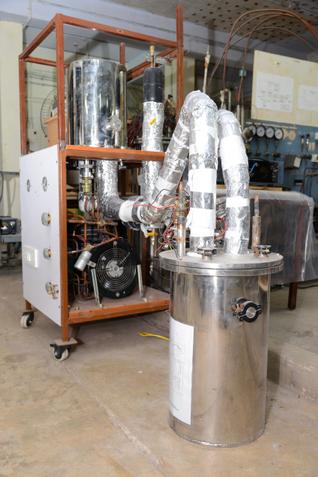Indian Institute Of Technology, Madras (IIT-Madras) engineers have designed a refrigerator that realizes temperatures up to -200 degree Celsius. The refrigerator employs a single stage vapor compressor that’s commonly used in domestic ACs and refrigerators, and has almost the same working pressure as the latter. Professor G. Venkatarathnam from the RAC (Refrigeration and Air-conditioning) Laboratory at the Department Of Mechanical Engineering claims that the machine was made to work non-stop at -200°C for a period of three months.

Conventionally, it’s easy to attain a temperature of -110°C, but what these IIT folks did is, they connected three refrigerators in series and made them work in sync to lower down the temperature. Prof. Venkatarathnam stresses on the main disadvantage of this technique saying that each stage demanded a compressor and some heat exchangers, and this resulted in a overall complex circuit, not to mention the additional costs.
Also going against conventional, where just a single liquid coolant is employed to absorb the heat, IITians developed a new technique where they used a mixture of coolants and converted the liquid to vapor over a range of temperatures in an internal heat exchanger. This lets the refrigerator touch -200°C. But Prof. Venkatarathnam maintains that many applications won’t be needing temperatures below -196°C. Major applications of this refrigerator includes food preservation, long-time biological tissue preservation, blood preservation, long term bull-semen storage and in electronic industry where intense cooling is required.
Indian Institute Of Technology, Madras (IIT-Madras) engineers have designed a refrigerator that realizes temperatures up to -200 degree Celsius. The refrigerator employs a single stage vapor compressor that’s commonly used in domestic ACs and refrigerators, and has almost the same working pressure as the latter. Professor G. Venkatarathnam from the RAC (Refrigeration and Air-conditioning) Laboratory at the Department Of Mechanical Engineering claims that the machine was made to work non-stop at -200°C for a period of three months.
Conventionally, it’s easy to attain a temperature of -110°C, but what these IIT folks did is, they connected three refrigerators in series and made them work in sync to lower down the temperature. Prof. Venkatarathnam stresses on the main disadvantage of this technique saying that each stage demanded a compressor and some heat exchangers, and this resulted in a overall complex circuit, not to mention the additional costs.
Also going against conventional, where just a single liquid coolant is employed to absorb the heat, IITians developed a new technique where they used a mixture of coolants and converted the liquid to vapor over a range of temperatures in an internal heat exchanger. This lets the refrigerator touch -200°C. But Prof. Venkatarathnam maintains that many applications won’t be needing temperatures below -196°C. Major applications of this refrigerator includes food preservation, long-time biological tissue preservation, blood preservation, long term bull-semen storage and in electronic industry where intense cooling is required.